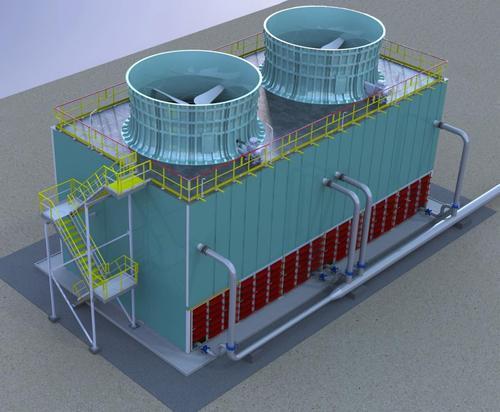How does the cooling tower startup work?
March 01, 2021 0 Comments

This is the time of year that in many parts of the country that seasonal (HVAC) cooling towers are beginning to start up. It is very important that you follow cooling tower start-up steps and best practices, and that the company or individual performing water treatment services for the tower be advised in advance of startup of these cooling towers.
The primary goal of effective water treatment is to provide and maintain clean heat transfer, piping, and other water contact surfaces. Even before cooling tower start-up, surfaces are exposed to the elements of air and water, and that has an impact on four main areas:
- Scale and deposition of organic and inorganic materials which impact heat transfer and may ultimately lead to reduced flow, and even total blockage of water flow.
- Corrosion which can lead to lack of efficiency of the cooling system, and may impact the tower’s ability to remove heat effectively and allowing drift. Ultimately it is corrosion that is the main reason towers are replaced.
- Microbiological control of system performance – Control of biofouling for prevention of biofilm formation, particularly on the condenser tubes impacting short-term efficient heat transfer, as well as long-term inhibition of microbial-induced corrosion.
- Microbiological control of Legionnaires’ disease – Control of Legionella proliferation in the cooling tower, to control the risk of Legionnaires’ disease associated with the tower operation.
It is therefore imperative that a preventive course of action begins before initial startup of cooling towers.
During cooling tower start-up, preliminary inspections of critical heat transfer surfaces and other susceptible areas should be made. In some states, this inspection is a requirement. If significant issues are found prior to start-up, they can be addressed immediately as opposed to attempting to make repairs when the tower is up and running. It is also important to make sure that the tower, as well as the rest of the condenser piping is clean before start-up, and that drift eliminators are repaired and/or replaced as necessary to minimize drift. Failure to clean before to start-up can lead to high bacteria counts including the presence of Legionella in excessive numbers, and possibly even plugging of system piping.
Recommendations for Cooling Tower Start-Up Steps and Processes
We recommend that the system be cleaned and sanitized in accordance with ASHRAE Guideline 12-2000 which calls for:
Cleaning all debris such as leaves, dirt, etc. from the cooling tower. Filling the System with water and operating the condenser pumps but not the fans, and then follow one of two protocols:
- Maintain the maximum recommended biocide using the biocide used prior the shutdown for a sufficient period of time (as recommended by the biocide manufacturer) or
- Treat the system with sodium hypochlorite to a level of 4 to 5 ppm of “free” chlorine at a pH of 7.0 to 7.6. Hold this residual for a period of six hours.
Once one of these two biocidal treatments has been successfully completed, and prior to the fan being turned on, wait for an hour, but no more than two weeks and obtain a Legionella sample and send it to a CDC ELITE Lab. Environmental Safety Technologies is a CDC ELITE Lab.
After testing, the fan can then be energized, and the system can be returned to service, and the standard water treatment program can continue, including the biological treatment. Because “demand” is often low for cooling towers in the Spring, they may operate in “pump only mode” and have little need for fresh water makeup. Since some Water Treatment programs are “demand-based” your water treatment program may not call for the addition of chemicals. It is therefore important to assure that the proper amounts of scale and corrosion inhibitors, and biocides are resident in the system water at startup, and for the few weeks of low demand that follow. To assure that the ongoing program is effective it is also recommended that a Legionella sample be taken two to three weeks after startup and then monthly during the operating season.
In addition to monthly Legionella testing, it is advised to also perform Heterotrophic Plate Count (HPC), or Dip Slides on a weekly basis. This is a legal requirement in some states, but it should be pointed out that there has been no correlation found between HPC counts and the presence of Legionella bacteria in cooling system waters. However, HPC counts and dip slides are useful in determining the presence of biological growth as it may impact system performance.
Starting with a clean tower is a very important measure in reducing energy consumption, corrosion potential, biological fouling, in addition to reducing the risk of disease.
You can find the original article @ https://estechlab.com/cooling-tower-start-up-steps/
Also in Blog

Advanced Cooling Tower Management: Enhancing Efficiency with Lakewood Model 140
February 28, 2024 0 Comments

Optimizing Cooling Tower Performance: Understanding Efficiency, Maintenance, and Water Quality Management
February 28, 2024 0 Comments

Revolutionizing Water Analysis: Everything You Need to Know About the Kemio KEM10DIS
April 19, 2023 0 Comments



